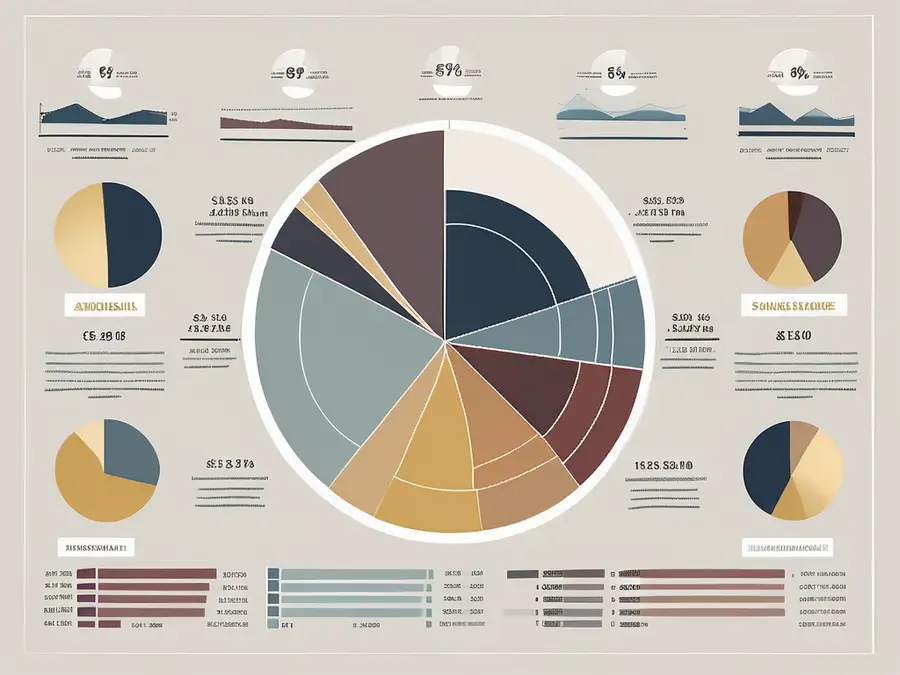The Importance of Asset Class Diversification in Your Investment Portfolio

As an expert in the field of investments, I cannot stress enough the significance of asset class diversification in your investment portfolio. It is a strategy that has proven to be effective in mitigating risks and maximizing returns. In this article, we will delve deep into the subject, understand its intricacies, explore the benefits, discuss key asset classes, learn how to implement it, and emphasize the importance of monitoring and adjusting your diversified portfolio.
Understanding Asset Class Diversification
Definition of Asset Class Diversification
Asset class diversification refers to the practice of spreading your investments across different asset classes, such as stocks, bonds, real estate, and more. By doing so, you can reduce the overall risk in your portfolio, as different asset classes tend to perform differently under various market conditions.
When considering asset class diversification, it's essential to understand the correlation between different asset classes. For example, historically, stocks and bonds have had a negative correlation, meaning when one performs well, the other may not. This negative correlation can be beneficial in reducing the overall volatility of a portfolio.
The Role of Asset Class Diversification in Investment
Asset class diversification serves as a crucial tool in managing risks. While some investment options might perform well in certain economic conditions, others may struggle. By combining various asset classes, you can shield your portfolio from the adverse effects of any single asset class's poor performance.
Furthermore, asset class diversification can also provide opportunities for growth. Different asset classes have different return profiles and growth potential. By diversifying your investments, you can potentially benefit from the growth of multiple sectors or industries, thus enhancing the overall performance of your portfolio.
The Benefits of Diversifying Your Investment Portfolio
When it comes to managing your investment portfolio, diversification is a key strategy that offers various advantages. In addition to risk management, diversification can also provide enhanced stability and resilience to your investments. By spreading your assets across different types of investments, such as stocks, bonds, real estate, and commodities, you can reduce the overall volatility of your portfolio. This means that even if one asset class experiences a downturn, the impact on your entire portfolio is minimized, helping you weather market fluctuations more effectively.
Enhanced Portfolio Stability
One often overlooked benefit of diversification is the enhanced stability it brings to your investment portfolio. Different asset classes have unique characteristics and tend to perform differently under various market conditions. For example, while stocks may offer high returns, they also come with higher volatility. On the other hand, bonds are known for their stability but may have lower growth potential. By diversifying your investments, you can create a balanced portfolio that can better withstand market uncertainties and economic downturns. This stability can provide you with peace of mind knowing that your investments are not overly reliant on the performance of a single asset class.
Risk Management through Diversification
One of the primary benefits of asset class diversification is risk management. By spreading your investments across a range of asset classes, you minimize the impact of any single investment's poor performance. This shields your portfolio from substantial losses and ensures a more stable long-term growth.
Potential for Higher Returns
Another benefit of diversifying your investment portfolio is the potential for higher returns. While some asset classes may underperform, others might outperform market expectations. By allocating your investments wisely, you can take advantage of the growth potential in different asset classes, therefore increasing your overall returns.
Key Asset Classes to Consider for Diversification
Bonds: Stability and Regular Income
Bonds are fixed-income investments that offer stability and regular income through interest payments. They are considered a low-risk asset class, making them an excellent choice for risk-averse investors. They provide steady income and act as a counterbalance to the volatility of other asset classes.
Stocks: High Growth Potential
Stocks represent ownership in a company and offer the potential for significant capital appreciation. They are known for their high growth potential but come with higher risks compared to bonds. Including stocks in your investment portfolio can provide an opportunity for substantial returns over the long term.
Real Estate: Tangible Assets and Rental Income
Real estate investments include properties such as residential, commercial, and rental properties. Real estate offers the advantage of tangible assets along with the possibility of earning rental income. It serves as a hedge against inflation and can provide a steady cash flow, making it an attractive addition to a diversified portfolio.
Implementing Asset Class Diversification
Assessing Your Risk Tolerance
Before implementing asset class diversification, it is vital to assess your risk tolerance. Understand your financial goals, time horizon, and ability to tolerate fluctuations in the market. This self-awareness will guide you in selecting the right mix of asset classes that align with your risk profile.
Determining Your Investment Goals
Clearly defining your investment goals is crucial in guiding your asset allocation decisions. Whether you aim for capital preservation, long-term growth, or a combination of both, your goals will dictate the proportions of different asset classes in your portfolio.
Allocating Your Assets
Once you have assessed your risk tolerance and determined your investment goals, it's time to allocate your assets across various asset classes. Consider the historical performance, risk characteristics, and correlation between different asset classes. A well-diversified portfolio usually includes a mix of stocks, bonds, real estate, and other suitable investment vehicles.
Monitoring and Adjusting Your Diversified Portfolio
The Importance of Regular Portfolio Reviews
Monitoring your diversified portfolio is essential to ensure it remains aligned with your investment goals. Regularly review your portfolio's performance, asset allocation, and make necessary adjustments to maintain the desired balance. Keep a watchful eye on market conditions and economic trends that may affect the performance of different asset classes.
Making Adjustments: When and Why?
Adjustments to your diversified portfolio should be made when there are significant changes in your risk tolerance, investment goals, or market conditions. Rebalancing your portfolio periodically helps restore the original desired asset allocation that may have drifted due to the varying performance of different asset classes over time.
Personal Advice: In my years of experience as an investment expert, I have witnessed the power of asset class diversification firsthand. It is crucial not to put all your eggs in one basket and instead embrace a diversified approach to investment. By spreading your investments across various asset classes, you can achieve a more balanced and robust portfolio, better geared to weather market fluctuations and maximize returns.
FAQ
Q: What is asset class diversification?
A: Asset class diversification refers to the practice of spreading your investments across different asset classes, such as stocks, bonds, real estate, and more. This strategy helps mitigate risks and maximize returns.
Q: How does asset class diversification help manage risk?
A: By diversifying your investments, you reduce the impact of any single investment's poor performance. Different asset classes tend to react differently to market conditions, so by combining them, you shield your portfolio from substantial losses.
Q: Which asset classes should I consider for diversification?
A: Some key asset classes to consider for diversification are bonds, stocks, real estate, and other suitable investment vehicles. Each asset class comes with its unique risk profile and growth potential, allowing you to create a well-rounded portfolio.
Q: How often should I review and adjust my diversified portfolio?
A: Regularly reviewing your portfolio's performance is essential. Depending on market conditions and changes in your financial goals, you may need to make adjustments. Rebalancing your portfolio periodically helps maintain the desired asset allocation.
Remember, asset class diversification is not a one-size-fits-all approach. Seek professional advice or conduct thorough research before making any investment decisions. With a diversified portfolio, you can navigate the ups and downs of the market with confidence and maximize your long-term investment success!
Ready to embrace the power of asset class diversification with a cutting-edge twist? Look no further than Morpher, the revolutionary trading platform that's redefining the investment landscape. With Morpher, you can diversify your portfolio across stocks, cryptocurrencies, forex, and even niche markets like NFTs, all with zero fees, infinite liquidity, and the safety of a non-custodial wallet. Whether you're a seasoned investor or just starting out, Morpher's fractional investing, short selling capabilities, and up to 10x leverage offer a unique trading experience tailored to your needs. Sign Up and Get Your Free Sign Up Bonus today to start trading on a platform that's as diverse and dynamic as your investment goals.

Disclaimer: All investments involve risk, and the past performance of a security, industry, sector, market, financial product, trading strategy, or individual’s trading does not guarantee future results or returns. Investors are fully responsible for any investment decisions they make. Such decisions should be based solely on an evaluation of their financial circumstances, investment objectives, risk tolerance, and liquidity needs. This post does not constitute investment advice.

Painless trading for everyone
Hundreds of markets all in one place - Apple, Bitcoin, Gold, Watches, NFTs, Sneakers and so much more.

Painless trading for everyone
Hundreds of markets all in one place - Apple, Bitcoin, Gold, Watches, NFTs, Sneakers and so much more.









